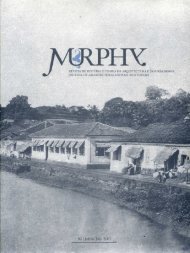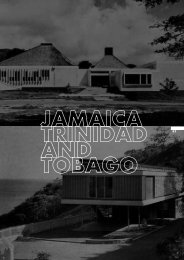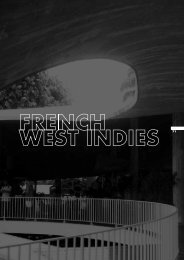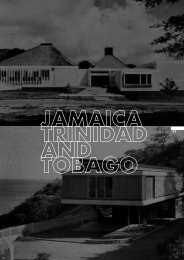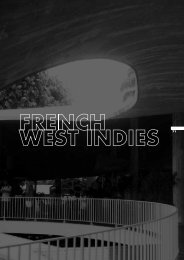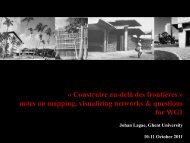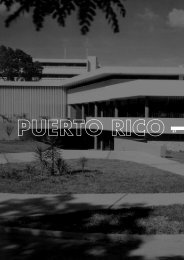Santo Domingo, Modernity and Dictatorship
Santo Domingo, Modernity and Dictatorship
Santo Domingo, Modernity and Dictatorship
Create successful ePaper yourself
Turn your PDF publications into a flip-book with our unique Google optimized e-Paper software.
Fig. 2. José Antonio Caro, José Ramón Báez et al, aerial photography of the campus of <strong>Santo</strong> <strong>Domingo</strong> University, circa 1945<br />
© photo Stopelman<br />
54<br />
the regime to appear as a modern, even democratic,<br />
government in its hotels, schools <strong>and</strong> hospitals, all of<br />
which are conceived <strong>and</strong> built in a mature modern idiom.<br />
On the other h<strong>and</strong>, buildings which house organs of<br />
social control, such as police detachments, court houses,<br />
fortresses <strong>and</strong> other government buildings, have an<br />
almost fascist look. Conforming to the semantics of the<br />
regime, they are called ‘palaces.’ 7<br />
THIS DOUBLE CODE also appeared in the works of some<br />
the main Dominican architects of the period, namely<br />
Guillermo González <strong>and</strong> José Antonio Caro. In his housing<br />
projects, González worked within a traditional idiom, <strong>and</strong><br />
in his institutional buildings he worked within a modern<br />
idiom, stark <strong>and</strong> of colossal scale. In his modern idiom, he<br />
was equally skillful in rotation (Hotel Jaragua) <strong>and</strong> frontalness<br />
(the Palace of the City Government of the Federal District).<br />
In his Secretariat of Education <strong>and</strong> his Central Bank, Caro<br />
does not impose himself, but rather minimizes his own<br />
personality, which results in a neoclassicism far from the<br />
modern plasticity of his Medical School of the University<br />
of <strong>Santo</strong> <strong>Domingo</strong> or from the Bauhaus rationality of the<br />
Engineering <strong>and</strong> Architecture School. 8<br />
THIS STYLISTIC INCONSISTENCY of modern architects<br />
is not exclusive to the Dominican Republic. In the preface<br />
to her fine book Malaussena: Arquitectura Academica en<br />
la Venezuela Moderna, Sylvia Hernández de Lasala,<br />
writes of the Venezuelan Luis Malaussena: “A worrying<br />
<strong>and</strong> seductive question arises which needs examination:<br />
how can a work like the headquarters of the Secretariat<br />
of the Presidency of the Republic, known as the White<br />
Palace, <strong>and</strong> of a neoclassic appearance, have been<br />
conceived at the same time as the Guaicamacuto Hotel,<br />
today the Marcuto Sheraton, <strong>and</strong> the Maracay Hotel,<br />
which are both examples of the purest international style?” 9<br />
Ever since Haussmann in the nineteenth century laid out<br />
long perspectives which were incidently also useful for<br />
controlling rebellions with grape-shot, almost all dictators<br />
have preferred imposing projects <strong>and</strong> gr<strong>and</strong> avenues in<br />
their urban plans. 10 We see this in Caracas in the<br />
monumental works of Malaussena <strong>and</strong> in Havana in the<br />
gr<strong>and</strong> avenues designed by Forestier. In <strong>Santo</strong> <strong>Domingo</strong>,<br />
during the consolidation of modernity which occurred<br />
during the Trujillo period, there was no structured will<br />
expressed in a master plan. Rather, what occurred was a<br />
series of unstructured works which fulfilled very defined<br />
needs but which in the end orchestrated a proposal for a<br />
modern city.<br />
The engineer Ramón Báez López-Penha wrote about<br />
the urban regulations enacted to remedy the effects<br />
of the 1930 hurricane San Zenon: “let us continue<br />
assembling housing developments mechanically <strong>and</strong><br />
uncreatively without any plan or specific goal so that<br />
we can continue to lack what we lack today, that is,<br />
clear <strong>and</strong> precise plans to guide us.” 11<br />
The direction of Máximo Gómez Avenue, also planned<br />
by Báez, demonstrated this lack of structural vision<br />
Docomomo N°33<br />
September 2005



